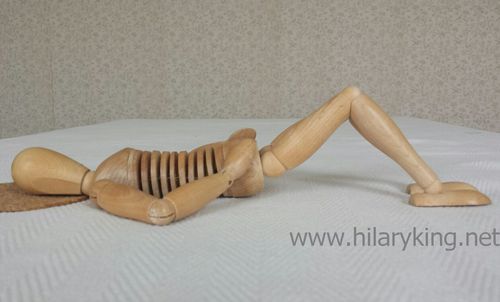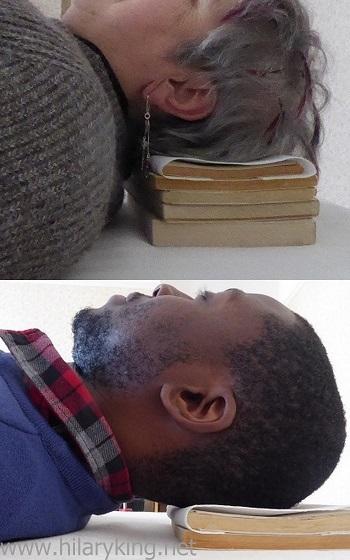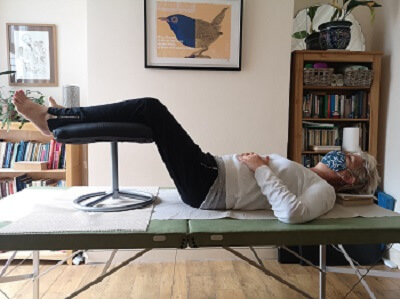The Constructive Rest Procedure
What do you need to know about practising the Lying Down Procedure?
It’s hard to find time – how long do I have to lie down for?
Ideally, you need about 20 minutes a day for the procedure, or a minimum of 10 minutes, as your body takes this sort of time to become unwind enough for changes to take place. This is particularly true when you are learning the procedure and developing your thinking skills. If you lie down more than once a day, subsequent sessions could be shorter. Some people find it helpful to use a timer or alarm, so that they don’t have to worry about when to stop.
The Active Rest Procedure offers you the quickest and easiest way to begin learning about the Alexander Technique and about your own body. You will get the most out of the money you pay for your lessons, if you work on yourself regularly!
Sometimes there will inevitably be occasions when we really do not have time or space to practise the lying down procedure. However, if you find this is a constant problem for you, ask yourself, why are you are living in such a hectic and probably stressful manner? Is it really the case that you can’t give yourself 10-20 minutes a day to look after yourself?
Perhaps you find you are resistant to doing the practise? This can happen for a variety of reasons: sometimes we can feel rebellious and do not want to let ourselves change; sometimes we can be afraid of thoughts and feelings that can surface when we let ourselves be quiet; or it can just seem uncomfortable to learn about ourselves. It may help you to talk to your teacher about some of these issues if you find they apply to you.
Just do it on a regular basis and you’ll find positive changes start happening in yourself.

Can I lie down in semisupine when pregnant?
This is fine during early pregnancy. However, after 28 weeks it is best to only lie on your back for brief periods. Research suggests that the weight of the mother’s organs can put pressure the baby in this position. You can use all the same AT thinking whilst lying on your side as you would in semisupine. Also, in order to look after your back, you can practice using some wall work.
Can I lie down on my bed to practise?
Ideally, no. The reason for this is that unless you have an exceptionally hard bed, the mattress will give way and won’t support your back, which will tend to become more curved, because the weight of your legs will push down into the bed as you lie in semi-supine. Your back, therefore, will be unable to lengthen and widen freely and your muscles find it harder to release tension.
Also, there may be more of a temptation to drift off into sleep, rather than to work on yourself with an alert mind, with awareness.
Of course, if you have mobility problems, or are experiencing a long period of illness, working on yourself whilst lying in bed can be extremely useful and can aid recovery. Remember, though, that if you can lie on the floor as well as the bed, the more effective the work will be.
I can’t remember what to think about when I practise
To begin with, just keep reminding yourself to have a free neck, inhibit any urge to move around and just do less. Become aware of what is going on in your body, mind and feelings and see if you can learn about how they relate to each other.
Over time, as you become more familiar with the procedure and the Technique, you want to give yourself directions and train your thinking to bring about changes in yourself whilst lying in semi-supine. See my article on the Lying Down Procedure for further information.
My friend uses a different amount of books to me, why?
We each need the amount of books that will allow our necks to release and lengthen when the head is resting on them. This release needs to take place equally, through both the back and the front of the neck. If the books are too high, the chin will be pushed in towards the neck and possibly restrict the throat. If the head is thrust too far forwards, this can also put pressure on vertebrae at the base of the neck.
Conversely, if the books are too low, the head will fall back and down onto the books, with the neck contracted and arched like a banana. In this position it will be less possible to let go of tension, free your muscles sand allow them to lengthen out again.

The height of books depends on each person’s head-neck-back relationship
Therefore the number of books used will vary depending on the shape of our bodies, so a child may not need any books, whilst some adults may need several.
Importantly, check the height of books that your teacher uses with you and make sure you have the same amount ready and waiting for you, where you practise the lying down procedure. It is easy to measure the height against your finger, so you know what to use next time.
The books hurt my head – what can I do about this?
Use paperback books, they are a bit softer than hardbacks. A cushion is too soft – it will give way, rather than your muscles letting go and giving way.
When you move to lie down, say ‘no’ to arching your neck as you put your head on the books. If we contract whilst lying down, we press down onto the books and make them seem harder. Instead, pause, give yourself directions to free your neck and allow your head to ease out and away from the top of the spine, as you place your head onto the books. Remember that the ‘up’ direction refers to a flow of energy up your spine (not to the ceiling).
Continue to give yourself directions whilst lying still and say ‘no’ to tightening your neck so you avoid arching and shortening. As you allow more ease, you will probably notice a reduction in the perceived hardness of the books.
If you continue to have problems, try putting a mouse mat or towel on top of the books. This is often soft enough to take the edge off the hardness.
The floor hurts my elbows
Before you try putting something softer under your elbows, check that you are not holding your arms and shoulders in a way that pushes your elbows onto the floor. Keep doing less, free your arms and allow them to ease out and away from your ribs and spine.
If the surface you are lying on is very hard, you could try placing a mouse mat or small towel under each elbow.
I’m travelling but books are heavy – what can I do?
Weight is a problem for holiday makers, musicians and people who travel for work.
A thin yoga mat can be helpful if you have stone or wood floors. You may like to take something as a pad for your elbows as well, as these mats are usually narrow.
Instead of books, you can cut up a gardening kneeling pad and keep it with your musical instruments or suitcase. These pads are light, cheap very portable yet dense enough to support your head. If you are concerned about the environment, there are environmentally friendly versions that you can buy.
Keeping your head rest pad with your equipment can also act as a visible reminder to lie down – particularly useful when life gets hectic!
I find it hard to free my legs because my feet keep slipping
Check the position of your feet on the floor. If you have placed them too far away from your body, they will tend to slip away. Also the weight of your legs may drag on your pelvis, possibly making your lower back arch. So, inhibit any urge to move without thought, then give yourself directions and bring one foot at a time closer in towards you. You want your heels to be more or less under your knees and your feet in alignment with them. Free your legs and allow them to ease up and away from your pelvis. Remind your feet not to grip the floor.
If your feet still tend to slip away, try wearing socks with non-slip soles. These are also cosy in cold weather, as you don’t want to get chilled whilst lying down. You can also try using a piece of mesh matting that is designed to go under carpets to stop them slipping. I use this on my Alexander teaching table – as you can see in the photo below.
How do I stop my knees falling outwards?
You can use a blanket over your knees. This will not stop your legs moving but will help stabilise them. You could also ease your heels outwards a little. This helps free up the muscles down the outside of your leg and reduce the outward pull.
If you put your legs up on a chair, as in the photo, this allows you to work on yourself without worrying about knees falling outwards.

Try putting your feet up on a chair
You can also lie with your legs supported on a chair for a change. This is useful if your legs or lower back are feeling sore, or legs tend to flop about as they release tension. Some people find it easier to free up the legs in this position.
Can I listen to music whilst lying down?
If you are just learning how to do the lying down procedure, it is best not to let yourself be distracted by something like music. You want to train your thinking and work on yourself during the procedure. Music or TV will take your mind away from your practise, maybe even encourage you to drift off into sleep. Then you will not develop AT skills and awareness, nor have this incredibly useful tool under your belt, so that you can use it to help look after yourself.
As you get more experienced at working on yourself, the aim is for you to be able to use your AT skills, whatever you are doing. So listening to music sometimes should not be a distraction but you will be able to listen and work on yourself at the same time. However, you will work on yourself better, if you give yourself undivided attention during the Active Rest procedure.
When is the best time of day to practise the lying down procedure?
The time that works best for you and your lifestyle is best. To begin with, many people find it helps them remember to practise, if they lie down at the same time each day and make it part of their routine. As you get more used to including the procedure into your life, you will probably find that the times you use will vary, according to your needs.
Some times you can consider
- First thing in the morning – allows you to start the day from a neutral place in yourself, set yourself up for the day and will encourage good use throughout your activities.
- Lunchtime – you can free yourself of tensions that have built up in the morning, restore your energy and prepare yourself for the afternoon.
- After work – allows you to let go of work and the tensions that built up during the day. It can also act as a period of transition between work and your private life, plus help you to approach the evening from a free place in yourself.
- Before bed – this is a good time to practise the lying down procedure, if you tend not to sleep well. As you work on yourself, you will allow your body to go into sleep freely, without dragging so much ‘stuff’ into sleep with you. However, it is all too easy just to fall asleep on the floor, in which case you will not have done much work on yourself and will have to wake yourself up in order to get into bed – rather counter-productive. If this tends to happen to you then it’s best to try the procedure at other times of day.
The main thing is to practise the lying down procedure every day. Just do it!
MORE QUERIES? Ask me at your next lesson. You are also welcome to email me or use the Contact Form to ask me any further questions you may have.